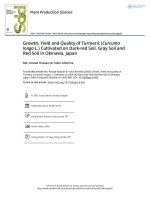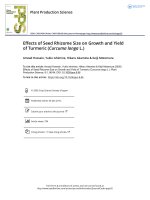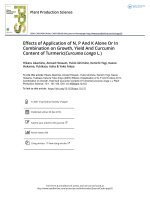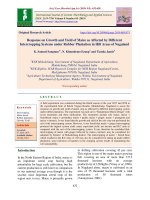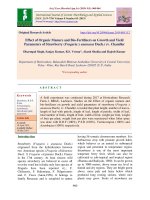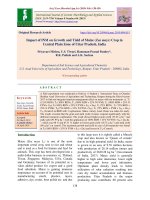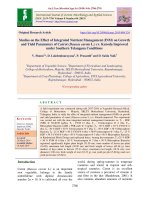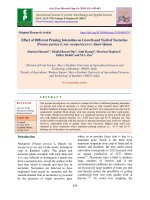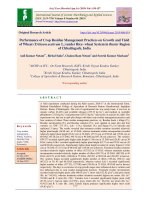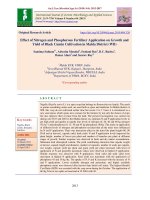Effects of Seed Rhizome Size on Growth and Yield of Turmeric Curcuma longa L
Bạn đang xem bản rút gọn của tài liệu. Xem và tải ngay bản đầy đủ của tài liệu tại đây (376.61 KB, 10 trang )
Plant Production Science
ISSN: 1343-943X (Print) 1349-1008 (Online) Journal homepage: />
Effects of Seed Rhizome Size on Growth and Yield
of Turmeric (Curcuma longa L.)
Amzad Hossain, Yukio Ishimine, Hikaru Akamine & Keiji Motomura
To cite this article: Amzad Hossain, Yukio Ishimine, Hikaru Akamine & Keiji Motomura (2005)
Effects of Seed Rhizome Size on Growth and Yield of Turmeric (Curcuma�longa L.), Plant
Production Science, 8:1, 86-94, DOI: 10.1626/pps.8.86
To link to this article: />
© 2006 Crop Science Society of Japan
Published online: 03 Dec 2015.
Submit your article to this journal
Article views: 794
Citing articles: 11 View citing articles
Full Terms & Conditions of access and use can be found at
/>
Plant Prod. Sci. 8 (1) : 86 ź 94 (2005)
Effects of Seed Rhizome Size on Growth and Yield of
Turmeric (Curcuma longa L.)
Md. Amzad Hossain, Yukio Ishimine, Hikaru Akamine and Keiji Motomura*
(Subtropical Field Science Center, Faculty of Agriculture, University of the Ryukyus,
Senbaru 1, Nishihara Cho, Okinawa 903-0213, Japan;
* Faculty of Agriculture, University of the Ryukyus, Senbaru 1, Nishihara Cho, Okinawa 903-0213, Japan)
Abstract : Turmeric (Curcuma longa L ) plant species produces different sizes of daughter rhizomes (R) and
mother rhizomes (MR), which are the only propagules (seed) for its cultivation. Here, we evaluated the effects
of seed rhizome size on growth and yield of turmeric. Daughter rhizomes of 5-50 g (R-5 g~R-50 g) and mother
rhizomes of 48-52 g (MR) were tested. The heavier the R up to 40 g, the better the plant growth, and the plants
from the R-30 g, R-40 g, R-50 g and MR grew similarly well. The seed rhizomes with a greater diameter developed
vigorous seedlings. The plants grown from R-30 g, R-40 g and R-50 g had a similar plant height, tiller number and
leaf number, which were significantly higher than those from lighter R. The plants from R-30 g, R-40 g and R-50
g had a significantly larger shoot biomass and higher yield than those from smaller R in both the greenhouse
and field experiments. R-50 g was easily broken at the time of planting, and had secondary and tertiary daughter
rhizomes, which developed thinner plants and resulted in a lower yield. The shoot biomass and yield were highest
in the plants grown directly from MR, and lower in the plants grown from daughter rhizomes attached to MR.
This study indicates that the turmeric seed rhizome should be 30-40 g with a larger diameter, and seed mother
rhizome should be free from daughter rhizomes.
Key words : Daughter rhizome, Early growth stage, Mother rhizome, Rhizome development, Shoot elongation
pattern.
ǽUse of turmeric (Curcuma longa L.), a rhizomatous
perennial plant of Zingiberaceae family, can be traced
back nearly 4000 years, to the Vedic culture in India,
when turmeric was the principal spice and also had
religious significance. Turmeric is listed in an Assyrian
herbal dating about 600 BC. Turmeric is widely used as
a spice, cosmetic and medicine in Bangladesh, India,
Myanmar, Pakistan, Sri Lanka and Thailand (Hermann
and Martin 1991; Ishimine et al., 2003). Curcuminoids
in turmeric have anti-infl ammatory, antimutagen,
anticancer, antibacterial, anti-oxidant, antifungal,
antiparasitic and detoxifying properties (Hermann
and Martine, 1991; Nakamura et al., 1998; Osawa et
al., 1995; Sugiyama et al., 1996; Uechi et al., 2000).
Curcumin and volatile oils of turmeric prevent tumor
formation, improve liver and kidney functions, and
could be used against biliary disorders, diabetic and
hepatic disorders (Hermann and Martin, 1991). Many
people in the world are taking turmeric in different
forms for promoting health.
ǽEvaluating the effects of seed size on growth and
development of plants is very important for increasing
yield in the plant species producing different sizes
of seed (Singh and Singh, 2003; Stougaard and Xue,
2004; Xue and Stougaard, 2002). An optimum seed
root in size of a specific root crop may develop healthy
seedling and vegetative parts, which subsequently
receive higher solar energy and maximize yield. In
general, ginger, potato, taro and turmeric (Curcuma
sp.) plants produce different sizes of propagules. The
turmeric plant propagates by mother rhizome (shoot
base) and daughter rhizome. The daughter rhizomes
of the species are considered to be different in size,
because primary daughter rhizomes developed from
the shoot base have secondary and tertiary daughter
rhizomes, which are different in size due to the
differences in developing time. In addition, all the
primary daughter rhizomes are not developed at a
time from a shoot base. Therefore, it is necessary to
determine the optimum size of seed rhizomes for
turmeric cultivation.
ǽMany studies on medicinal value of turmeric
have been published but very few on its cultivation
(Hermann and Martin, 1991; Ishimine et al., 2003).
Turmeric is commercially cultivated in the southwestern part of Japan due to the subtropical climate,
but its production is limited because of the local
farmers lack proper cultivation technology (Akamine
et al. 1994, 1995; Aoi et al., 1988; Aoi, 1992; Ishimine et
al., 2003). Typhoons hit Okinawa several times a year,
and cause severe damage to plants. It was hypothesized
that the plants from the optimum seeds in size could
Received 12 April 2004. Accepted 13 September 2004. Corresponding author: Y. Ishimine (, fax
+81-98-895-8741).
Hossain et al. źź Effects of Seed Rhizome Size on Growth and Yield of Turmeric
87
establish better, and survive well in typhoon disaster
by developing roots and increasing shoot diameter.
We have determined optimum planting time, depth,
pattern and space of planting for turmeric cultivation
(Ishimine et al., 2003, 2004). Present study has been
undertaken to evaluate the effect of seed rhizome size
on growth and yield of turmeric.
Materials and Methods
1.ǽTrial site and soil characteristics
ǽTwo greenhouse and two fi eld experiments were
conducted in 1999-2000 and 2003 at the Subtropical
Field Science Center of the University of the Ryukyus,
Okinawa (24-28º N. Mean yearly ambient temperature,
rainfall and percent humidity during 1999-2003
were 23.3Ă0.2 ºC, 2198Ă436 mm and 72.2Ă2.1%,
respectively. Data were collected from the Meteorology
Branch Office, Naha), Japan. The experiments were
conducted on dark red soil (Shimajiri Maji, Chromic
Luvisols) containing 0.8% organic matter, 0.89%
C, 0.11% N, 134 mg P per 100 g soil, and pH 6.08.
Percent (w/w) clay, silt and sand were 66.3, 29.3 and
4.4%, respectively, and bulk density of soil (g cm-3) was
0.85. Exchangeable K, Ca, Mg and Na were 0.17, 10.8,
1.35 and 0.31 meq (milligram equivalent) per 100 g
soil, respectively.
2.ǽGreenhouse experiment 1999-2000
ǽThis experiment was conducted from April 20,
1999 to January 28, 2000, using wagner pots (size 0.05
m2). Each pot was filled with 10 kg of air-dried soil.
The seed rhizomes used in this experiment as the
treatments were daughter rhizome (R) of 5 g (R-5 g),
R-10 g, R-15 g, R-20 g and mother rhizome of 48-52 g
(MR). One seed rhizome per pot was planted at the
depth of 6 cm. Each treatment had 10 replications (10
pots). Chemical fertilizer (N : P2O5 : K2Oᴺ1 : 1 : 2) was
applied at 4 g pot-1 3 times at a 60-day interval from the
2nd to 3rd leaf stage. Water was supplied adequately
every day for maintaining optimum soil moisture level
for proper seedling emergence and plant growth.
3.ǽGreenhouse experiment 2003
ǽThis experiment was conducted from 22 April to 15
December 2003. Each wagner pot (size 0.05 m2) was
filled with 10 kg of air-dried soil and 1 kg of farmyard
manure (cow dung). The seed rhizomes used were
R-20 g, R-30 g, R-4 g, R-50 g and MR. Each treatment
had 6 replications. Soil, plantation procedure,
chemical fertilizer, and water used in this experiment
were the same as those in 1999-2000. We did not use
R-5 g, R-10 g, and R-15 g because they showed a very
low yield in preceding experiment (1999-2000).
4.ǽField experiment 1999-2000
ǽThe experiment was conducted from April 20, 1999
to February 5, 2000. The field was plowed to a depth
Fig.ǽ1.ǽEffects of seed rhizome size on pseudostem
diameter of turmeric seedling 10 cm in height.
R: daughter rhizome; MR: mother rhizome. Data
are meansĂSD. Data were from 10 seedlings for
each treatment in both the greenhouse and fi eld
experiments in 1999-2000. Bars with the same letter are
not significantly different at 5% level, as determined by
LSD test.
of 35 cm, and 6-m long ridges spaced 150 cm apart
were made by furrowing. The seed rhizomes used
treatments were R-10 g, R-20 g, R-30 g, R-40 g and MR.
Each treatment had three replications (three ridges),
and 42 seed rhizomes were planted manually at the
10 cm depth with 30 cm space in two rows on each
ridge. Chemical fertilizer (N : P2O5 : K2Oᴺ1 : 1 : 2)
was applied at 300 kg ha-1 3 times at a 60-day interval
from the 2nd to 3rd leaf stage. Overhead irrigation
was given immediately after turmeric planting and
fertilizer application. Weeding was performed by hand
at 45, 85 and 130 days after planting (DAP).
5.ǽField experiment 2003
ǽThis experiment was conducted from April 23 to
December 15, 2003 in the same field. The field was
plowed to 35 cm depth, and 4-m long ridges spaced
150 cm apart were made by furrowing. The seed
rhizomes tested were R-20 g, R-30 g, R-40 g, R-50 g
88
Plant Production Science Vol.8, 2005
Fig.ǽ2.ǽEffects of seed rhizome size on turmeric plant height. R: daughter rhizome; MR: mother
rhizome. Data are meansĂSD. Data were from 5 and 6 plants for each treatment in the greenhouse
experiment 1999-2000 and greenhouse experiment 2003, respectively. In both field experiments, data
were from 6 plants for each replication at 105 days after planting and means were calculated, then
means for the treatments were calculated from three replications. Bars with the same letter are not
significantly different at 5% level, as determined by LSD test.
and MR. Each treatment had three replications, and
each replication had 3 ridges where 84 seeds were
planted. Turmeric plantation procedure, fertilizer and
water used in this experiment were similar to the field
experiment in 1999-2000. Hand hoeing was done at
60, 120 and 160 DAP.
6.ǽProcedures of data collection and statistical
analysis
ǽSeedlings were counted at 10-day intervals until all
seedlings emerged. Seedling (pseudostem) diameter
was measured at the soil surface when seedlings grew at
least 10 cm in height. Length and width of the first and
second leaf blade of the seedlings were measured for
the second greenhouse experiment. Shoot elongation
was recorded at 15-day intervals until the shoots
length reached a plateau in greenhouse experiments.
Number of tillers (shoots) and leaves was counted at
135 and 120 DAP in the greenhouse experiment in
1999-2000 and 2003, respectively. In the greenhouse
experiment in 1999-2000, fi ve plants from each
treatment were harvested at 165 DAP, and leaf area
and dry weight of leaf, shoot and rhizome (yield) were
measured. The remaining five plants were harvested
at maturity when all shoots withered completely (280
DAP). For the greenhouse experiment in 2003, all
plants were harvested at maturity (240 DAP). Dry
weight of shoots and rhizomes were measured for both
the greenhouse experiments. In the field experiment
in 1999-2000, plant height, number of tillers and
leaves, leaf area, and dry weight of shoots and rhizomes
were measured for six plants from each replication at
105 DAP. Turmeric shoot damage caused by typhoons
was visually evaluated on the basis of shoot broken
and uprooting; and damage recovery level was visually
evaluated on the basis of new leaf and tiller formation,
and shoot survival. Canopy structure was also visually
evaluated. At maturity, the dry weight of shoots and
Hossain et al. źź Effects of Seed Rhizome Size on Growth and Yield of Turmeric
89
Fig.ǽ3.ǽEffects of seed rhizome size on tiller formation of turmeric plants. R: daughter rhizome; MR:
mother rhizome. Data are meansĂSD. Data were from 5 and 6 plants for each treatment in the
green experiment 1999-2000 and greenhouse experiment 2003, respectively. For both the field
experiments, data were from 6 plants for each replication and means were calculated, then means for
the treatments were calculated from three replications. Bars with the same letter are not significantly
different at 5% level, as determined by LSD test.
rhizomes was measured for both field experiments.
The number of primary daughter rhizomes was
counted for 10 plants from each treatment in the field
experiment in 1999-2000. Weed biomass was measured
at weeding time. Plant parts were oven-dried at 80 ºC
for 48 hr and weighed. Means and standard deviations
(SD) of samplings were determined using analysis of
variance (ANOVA). Fisher's Protected LSD test at the
5% level of significance was used to compare treatment
means.
Results
1.ǽSeedling emergence, seedling stem diameter and
plant height
ǽSeedlings emerged at almost the same time
irrespective of the size of seed rhizomes. Seedling
stems were thinner when emerged from R-5 g~R-20
g in both the greenhouse and field experiments, and
seedlings from R-30 g, R-40 g and MR had a similar
stem diameter in the field experiment (Fig. 1). Plant
height increased rapidly until 135 days after planting
(DAP), and it increased slowly thereafter up to 160
and 180 DAP in 1999-2000 and 2003, respectively, and
reached a constant height in all treatments in both
greenhouse experiments (Fig. 2). The larger the seed
rhizome, the higher the plant height throughout the
observation periods in both greenhouse experiments,
but in a greenhouse experiment of 2003, the heights of
plants from all seed rhizomes were similar at 180 DAP.
The height of plants in fi eld experiments also
increased with increasing size of seed rhizome. The
height of the plants from MR was significantly lower
than those from R-40 g in the first experiment (Fig. 2),
whereas it was the highest in the second experiment.
However, the plants from R-30 g, R-40 g and R-50 g in
the second experiment reached the same level, and
these plants were significantly taller than the plants
grown from smaller seed rhizomes.
90
Plant Production Science Vol.8, 2005
Fig.ǽ4.ǽEffects of seed rhizome size on leaf formation of turmeric plants. R: daughter rhizome; MR:
mother rhizome. Data are meansĂSD. Data were from 5 and 6 plants for each treatment in the
greenhouse experiment 1999-2000 and greenhouse experiment 2003, respectively. For both the field
experiments, data were from 6 plants for each replication and means were calculated, then means for
the treatments were calculated from three replications. Bars with the same letter are not significantly
different at 5% level, as determined by LSD test.
2.ǽNumber of turmeric tillers
ǽIn the greenhouse experiments, the number of
tillers increased with the increase in seed size (Fig.
3). In 1999-2000, it was signifi cantly lower in the
plants from R-5 g~R-15 g than in those from R-20 g
and MR but in 2003, the plants from R-40 g, R-50 g
and MR produced a similar number of tillers, which
were signifi cantly higher than that produced from
smaller ones. In the field experiment in 1999-2000,
significantly lower number of tillers was produced in
the plants from R-20 g or R-10 g compared with the
plants from larger seed, and the plants from R-30 g,
R-40 g and MR produced nearly the same number of
tillers (Fig. 3). In the field experiment in 2003, nearly
the same number of tillers was produced in the plants
from R-20 g, R-30 g, R-40 g, R-50 g and MR (Fig. 3).
3.ǽNumber of leaves, leaf area and leaf dry weight of
turmeric
ǽIn the greenhouse experiments, the number of
leaves per plant increased with the increase in seed
size (Fig. 4). In the first experiment (1999-2000) the
plants from R-20 g and MR had a larger number of
leaves, whereas in the second experiment (2003) the
number of leaves was significantly largest in the plants
from R-50 g followed by those from MR and R-40 g,
compared to smaller seeds (Fig. 4). In the first field
experiment, the number of leaves was markedly higher
in the plants from R-30 g, R-40 g and MR than in
those from R-10 g and R-20 g, whereas in the second
experiment, the plants from R-20 g, R-30 g, R-40g,
R-50 g and MR produced almost a similar number of
leaves (Fig. 4). Leaf area, and dry weight of leaves and
pseudostem increased with the larger seed rhizomes in
both the greenhouse and field experiments (Table 1).
The leaf area, and dry weight of leaves and pseudostem
were highest in the plants from MR in greenhouse
experiment, but they were highest in the plants
Hossain et al. źź Effects of Seed Rhizome Size on Growth and Yield of Turmeric
91
Tableǽ1.ǽEffects of seed rhizome size on the leaf area, and dry weight of leaves, pseudostem and rhizome of the plants harvested
at 165 and 105 days after planting in glasshouse and field experiment, respectively in 1999-2000 cropping season.
R: daughter rhizome; MR: mother rhizome (48-52 g);ᴪ: experiment not conducted. Data are meansĂSD. Data were from
5 plants for each treatment in greenhouse experiment. In the field experiment, data were obtained from six plants for each
replication and means were calculated, then means for the treatments were calculated from three replications. Means with the
same letter within each column are not significantly different at 5% level, as determined by LSD test.
from R-40 g followed by R-30 g and MR in the field
experiment.
4.ǽTurmeric shoot biomass
ǽIn the 1999-2000 season, the shoot biomass at the
first harvest (165 DAP in the greenhouse, 105 DAP
in the field) increased with the increase in seed size
in both the greenhouse and field experiments, and
that in the greenhouse experiment was significantly
larger in the plants from the seeds above 15 g than in
those from smaller seeds (Fig. 5). In 2003, however,
the shoot biomass in the greenhouse was larger in
the plants from R-30 g, R-40 g, R-50 g and MR than in
those from R-20 g (Fig. 5). In 1999-2000, shoot biomass
in the field was largest in the plants from R-30 g and
R-40 g but in 2003, it was largest in the plants from MR
(Fig. 5).
5.ǽTurmeric yield
ǽTurmeric yield at first harvest 165 and 105 DAP in
the greenhouse and fi eld experiment, respectively
increased with the increase of seed size in both the
greenhouse and field experiments, and the plants from
R-5 g~R-20 g produced a significantly lower yield than
those from a larger R (Table 1). At final harvest, the
yield was reduced significantly in the plants from R-5
g~R-15 g and was statistically similar in the plants from
R-20 g and MR in the first greenhouse experiment
(1999-2000), whereas in the second greenhouse
experiment (2003), the plants from R-20 g, R-30 g,
R-40 g, R-50 g and MR produced a similar yield (Fig.
6). Turmeric plants from R-40 g produced the highest
yield followed by those from R-30 g, and the plants
from MR had a signifi cantly lower yield than those
from R-30 g and R-40 g in the first field experiment,
whereas in the second experiment MR had the highest
yield, and the yield did not differ among the plants
from R-20 g, R-30 g, R-40 g and R-50 g. However, yield
increased somewhat with the increase of seed size.
Discussion
ǽWe found only a 5- to7-day difference in seedling
emergence from the seed rhizomes of different
sizes, but the difference was not significant because
turmeric requires around 50 days to complete
seedling emergence. Turmeric seedlings from larger
seed rhizomes were healthier because larger seed
rhizomes had larger buds. Not only the weight but
also the diameter of seed rhizome is the factor for
producing vigorous seedlings. It was observed that the
rhizomes with a larger diameter had larger buds, which
developed vigorous seedlings (data not presented).
Larger seed rhizomes contain a larger amount of
reserves that enhanced seedling growth, which
ultimately resulted in a taller plant (Fig. 2). In tropical
soda apple and spring wheat, Akanda et al. (1996), and
Stougaard and Xue (2004) reported that larger seed
produced longer coleoptiles, and had higher reserves,
which improved seedling establishment. In the present
study, the greater differences in plant height were
observed among the seed rhizomes of different sizes
during early growth stage of 135 days after planting,
because the amounts of reserved nutrients effective
in the initial plant growth stage were different.
Thereafter, the plant height became similar in all
plants from seed rhizomes of different sizes, because
all plants were applied a similar amount of nutrients.
However, as a whole, the plants from the seed rhizomes
92
Plant Production Science Vol.8, 2005
Fig.ǽ5.ǽEffects of seed rhizome size on shoot biomass of turmeric. R: daughter rhizome; MR:
mother rhizome. Data are meansĂSD. Data were from 5 and 6 plants for each treatment in the
greenhouse experiment 1999-2000 and greenhouse experiment 2003, respectively. For both the
field experiments, data were from all plants for each replication and means for the treatments were
calculated from three replications. Bars with the same letter are not significantly different at 5%
level, as determined by LSD test.
below 20 g could not reach the plant height similar
to that from larger seed rhizomes, and the plants
from R-30 g, R-40 g, R-50 g and MR reached almost
a similar height. At the initial stage, the difference
in the number of leaves was not large because the
seedlings emerged almost at the same time, but leaf
size was bigger when the seed was larger. After the
initial stage, the number of leaves increased as the
seed size increased, because the plants from the larger
seeds were longer and had a larger number of tillers.
The shoots with a larger leaf number and larger leaf
size received a higher solar energy for photosynthesis,
which ultimately resulted in a larger shoot biomass
(Fig. 2). This result is in agreement with the report of
Sarker et al. (2001) on rice plant.
ǽShoot biomass of turmeric plants increased with
increasing seed size in all the experiments, which was
consistent with the results in wheat crop (Singh and
Singh, 2003). But the shoot biomass of turmeric was
similar and higher in the plants from R-20 g and MR
in the greenhouse experiment in 1999-2000, and it
was the highest in the plants from R-50 g followed by
those from R-40 g, MR and R-30 g in the greenhouse
experiment in 2003 (Fig. 5). Similarly, Santos et
al. (1997) reported that shoot biomass of purple
nutsedge was increased signifi cantly by increasing
seed tuber weight up to 0.75 g, and only slightly by
a further increase in the tuber weight up to 1 g. In
the fi eld experiments, shoot biomass of turmeric
increased markedly as the size of seed rhizomes
increased because plants from larger seed rhizomes
were healthier and taller (Fig. 1,2), and shoot damage
caused by typhoon (September 22, 1999 (968.8 hPa,
35.2 m s -1); August 7, 2003 (956.5 hPa, 27.4 m s -1);
September 19-20, 2003 (985.8 hPa, 18.4 m s-1)) was less
and recovery was earlier when larger rhizomes were
planted (data not presented). In our previous studies,
the shoot biomass of turmeric increased as the tiller
Hossain et al. źź Effects of Seed Rhizome Size on Growth and Yield of Turmeric
93
Fig.ǽ6.ǽEffects of seed rhizome size on final yield of turmeric. R: daughter rhizome; MR: mother
rhizome. Data are meansĂSD. Data were from 5 and 6 plants for each treatment in the greenhouse
experiment 1999-2000 and greenhouse experiment 2003, respectively. For both the field experiments,
data were from all plants for each replication and means for the treatments were calculated from
three replications. Bars with the same letter are not significantly different at 5% level, as determined
by LSD test.
number and plant height increased, and a healthier
shoot was less affected by typhoon and rapidly
recovered, which ultimately resulted in a larger shoot
biomass (Hossain et al., 2000; Ishimine et al., 2003,
2004).
ǽThe larger the seed rhizome, the higher the
turmeric yield in most of the experiments due to
larger shoot biomass (Fig. 6). However, as a whole,
the yield was similarly higher in the plants from R-30
g~R-50 g, because they had a larger shoot biomass
and showed similar shoot growth. This result was
consistent with the results of Hossain et al. (2000) and
Ishimine et al. (2003). In addition, plants from the
larger seeds (R-30 g~R-50 g) had a bigger shoot base
in all experiments, which produced a higher number
of daughter rhizomes (data not presented). It was also
observed that the plants from larger seed rhizomes
R-30 g~R-50 g produced daughter rhizomes earlier in a
higher number, which ultimately increased the yield of
turmeric.
ǽStougaard and Xue (2004) found that the yield of
spring wheat increased as the seed size increased up
to 37 g (TKW), and further increase in seed size had
little effect. Santos et al. (1997) also reported that
the yield of purple nutsedge increased as the tuber
size increased up to 0.75 g. From these results, it was
thought that the yield of a crop plant increased as the
seed size increased up to a certain level, and a further
increase in seed size had little effect on the yield. The
present experiment indicated that turmeric yield was
highest when the seed rhizomes were R-30 g~R-50 g.
ǽShoot dry weight and yield of the plants from MR
were significantly less than those of the plants from
R-30 g and R-40 g in the first field experiment, because
some plants developed from the daughter rhizomes
attached to the MR. On the other hand, the shoot
dry weight and yield were the highest in the plants
from MR in the second experiment, because all
94
Plant Production Science Vol.8, 2005
plants developed directly from MR (Fig. 5, 6). These
experiments suggested that seed mother rhizome
should be free from daughter rhizomes. Shoot dry
weight and yield in the second greenhouse experiment
w e r e a r o u n d t e n t i m e s g r e a t e r t h a n t h e fi r s t
experiment (1999-2000) (Fig. 5, 6). This was because
farmyard manure (cow dung) was used in the second
experiment.
ǽWeed biomass was not affected by seed size with 45
DAP, because canopy structure did not develop during
this period. Thereafter, weed biomass was smaller
when larger seed rhizomes were planted because
they developed a better canopy structure. This result
is consistent with the result of the experiment of
Ishimine et al. (2003) in the field.
Conclusion
ǽAll the trials in this study showed that seedlings from
R-30 g, R-40 g, R-50 g and MR were similarly healthy.
Plants from R-30 g, R-40 g and R-50 g had almost the
same height and number of tillers and leaves, which
were signifi cantly higher than those in the plants
from the smaller seed rhizomes. Turmeric plants from
R-30 g~R-50 g developed canopy structure earlier
which ultimately reduced weed biomass. The plants
from R-30 g~R-50 g were less affected by typhoon and
they recovered faster, compared with the plants from
smaller seed rhizomes. Shoot biomass was similar and
significantly higher in the plants from R-30 g~R-50 g,
compared with that of the plants from smaller seed
rhizomes. The plants from R-30 g~R-50 g had a larger
shoot base, which developed daughter rhizomes earlier
in a higher number and had a similarly high yield in
each experiment. The plants from MR had the highest
shoot biomass and yield. On the other hand, the shoot
biomass and yield were lower in the plants produced
from the daughter rhizomes attached to the MR. The
seed rhizome of 50 g must include secondary and
tertiary daughter rhizomes, and the plants developing
from secondary and tertiary daughter rhizomes result
in a lower yield. In addition, the seed of 50 g was
easily broken when planted. Not only the weight but
also the diameter of seed rhizome is the factor for
selecting good seeds of turmeric. The results of this
study suggest that turmeric seed rhizomes should have
a larger diameter and be within 30-40 g, and daughter
rhizomes must be removed from the seed mother
rhizome.
References
Akamine, H., Goya, A., Tomoyose, T., Kanna, K., Fukuti, S. and
Kinjo, K. 1994. Studies on characteristics and cultivation of
turmeric. (1) Plant characteristics of turmeric and effect of
fertilizer. Sci. Bull. Agr. Univ. Ryukyus 41 : 335-341**.
Akamine, H., Ishimine, Y. and Murayama, S. 1995. Studies on
characteristics and cultivation of turmeric (Curcuma longa L.).
(2) Effects of shading on the growth and yield of turmeric.
Sci. Bull. Agr. Univ. Ryukyus 42 : 133-137**.
Akanda, R. U., Mullahey, J. J. and Shilling, D. G. 1996.
Environmental factors affecting germination of tropical soda
apple (Solanum viarum). Weed Sci. 44 : 570-574.
Aoi, K., Yamamoto, H., Nagoe, T. and Kusunoki, T. 1988.
Production technology of medicinal plant turmeric. Agric.
Hortic. 63 : 1317-1322 *.
Aoi, K. 1992. Characteristics and cultivation of medicinal plant
turmeric. Agric. Hortic. 67 : 507-511*.
Hermann, P. T. A. and Martin, A. W. 1991. Pharmacology of
Curcuma longa. Planta Med. 57 : 1-7.
Hossain, M. A., Matsuura, S., Nakamura, I., Doi, M. and
Ishimine, Y. 2000. Studies on application methods of Manda
31 for turmeric (Curcuma spp.) cultivation. Sci. Bull. Agr.
Univ. Ryukyus 47 : 137-144.
Ishimine, Y., Hossain, M. A., Ishimine, Y. and Murayama, S.
2003. Optimal planting depth for turmeric (Curcuma longa
L.) cultivation in dark red soil in Okinawa Island, Southern
Japan. Plant Prod. Sci. 6 : 83-89.
Ishimine, Y., Hossain, M. A., Motomura, K., Akamine, H. and
Hirayama, T. 2004. Effects of planting date on emergence,
growth and yield of turmeric (Curcuma longa L.) in Okinawa
Prefecture, Southern Japan. Jpn. J. Trop. Agric. 48 : 10-16.
Nakamura, Y., Ohto, Y., Murakami, A., Osawa, T. and
Ohigashi, H. 1998. Inhibitory effects of curcumin and
tetrahydrocurcuminoids on tumor promoter-induced reactive
oxygen species generation in leukocytes in vitro and in vivo.
Jpn. J. Cancer Res. 89 : 361-370.
Osawa, T., Sugiyama, Y., Inayoshi, M. and Kawakishi, S. 1995.
Antioxidative activity of tetrahydrocurcuminoids. Biosci.
Biotech. Biochem. 59 : 1609-1612.
Santos, B. M., Morales-Payan, J. P., Stall, W. M. and Bewick,
T. A. 1997. Infl uence of tuber size and shoot removal on
purple nutsedge (Cyperus rotundus) regrowth. Weed Sci. 45 :
681-8683.
Sarker, M. A. Z., Murayama, S., Ishimine, Y. and Nakamura, I.
2001. Physio-morphological characters of F1 hybrids of rice
(Oryza sativa L.) in Japonica-Indica crosses. II. Heterosis for
leaf area and dry matter accumulation. Plant Prod. Sci. 4 :
202-209.
Singh, D. K. and Singh, V. 2003. Seed size and adventitious
(nodal) roots as factors influencing the tolerance of wheat to
waterlogging. Aust. J. Agric. Res. 54 : 969-977.
Stougaard, R. N. and Xue, Q. 2004. Spring wheat seed size and
seedling rate effects on yield loss due to wild oat (Avena fatua)
interference. Weed Sci. 52 : 133-141.
Sugiyama, Y., Kawakishi, S. and Osawa, T. 1996. Involvement
of the β -diketone moiety in the antioxidative mechanism of
tetrahydrocurcumin. Biochem. Pharmacol. 52 : 519-525.
Uechi, S., Miyagi, Y., Ishimine, Y. and Hongo, F. 2000.
Antibacterial activity of essential oils from Curcuma sp.
(Zingiberaceae) cultivated in foodborne pathogenic bacteria.
Jpn. J.Trop. Agr. 44 : 138-140.
Xue, Q. and Stougaard, R. N. 2002. Spring wheat seed size and
seedling rate affect wild oat demographics. Weed Sci. 50 :
312-320.
ǽ* In Japanese
ǽ** In Japanese with English abstract
